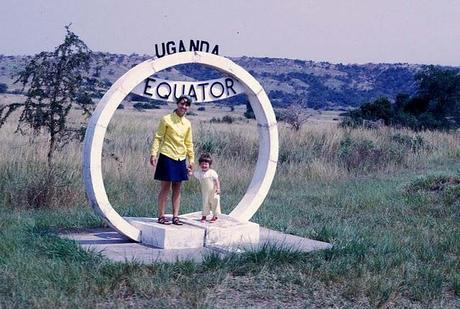
Caroline and Jennifer (age 18 months), Uganda, 1971
Trip of a Lifetime, East Africa, 1971
In 1971, my husband, Art, along with four other graduate students at Rockefeller University in New York, embarked on a four month field course in animal behavior in western Uganda. I didn’t want to miss out on a chance to go to Africa, even with a year-old baby (our daughter, Jennifer) to look after. One other student wife, Mary Sue, went along on the trip and we became traveling companions. During the first six weeks of the course, while our husbands were working in a forest near Fort Portal, Mary Sue, Jennifer, and I traveled by ourselves to Kenya and Tanzania. Then, for the second half of the course, which was conducted in a savannah environment in Queen Elizabeth National Park, we were able to join our husbands.
This year, 2011, marks the 40th anniversary of the Africa trip, a key life event for everyone who participated. The following reminiscences were part of a collection of memories compiled to mark the occasion and to honor of Peter Marler, who conceived of and organized the trip. The Africa trip experience can never be repeated. Africa, and we, have changed greatly in the last forty years. This blog post is strictly a trip down memory lane. I hope you will enjoy reading it.
Impact on My Life
As a wife, I was not involved with the course itself, but without it I would never have had the opportunity to go to Africa. At the time, I had not yet begun to write books for children, but my experiences seeing wildlife, meeting people who lived and worked in Africa, and just being there has been important for many of the books I’ve written since then. In a larger sense, the trip also greatly impacted my world view. Before then, I had never traveled outside the United States and had no idea what it was like to live in a third world country or in a place so rich with wildlife. From the time I was a child, I had always dreamed of travel and adventure. The trip to Africa certainly fulfilled that dream. When I do school presentations and kids ask me what was the most exciting place I’ve ever been, the answer is always the same–Africa.
My memories of the three months in Africa are vivid, reinforced by the hundreds of photos we took (some appear in my books) and by letters and diary entries. My parents eagerly awaited my weekly letters, vicariously traveling Africa with me. My father typed all the letters, making them legible, and put them into a book. I have put a few excerpts below. I used my diary mostly to record animal sightings, brief reports of the events of the day, and our dinner menus. One entry says we ate stewed waterbuck, from meat given to us by a park ranger! The diary also documents the arrival of the Marler family at QE, a greatly anticipated event.
Thank You, Peter Marler
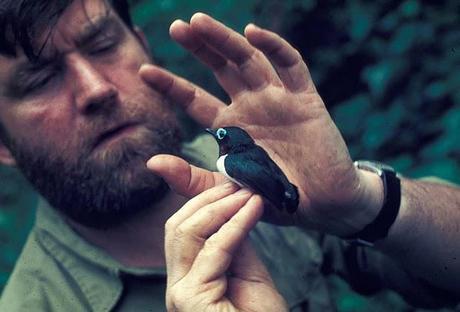
Dr. Peter Marler and Jameson's Wattle in the Kibale Forest near Fort Portal
I remember that Peter Marler had accompanied us on the trip from New York to Uganda, herding us through the airport like a troupe of wayward Cub Scouts. He had made this trip before, and I was grateful for his expertise both in the larger organization and in the details. In the Amsterdam airport, he introduced us to smoked eel sandwiches. In Kampala he took us to an Indian restaurant to try the delicious East African style samosas. He also pointed out the “bat tree” along the main road, where hundreds of fruit bats hung like small black umbrellas during the day. After helping the students set up at Kanyawara, Peter went back to New York, returning a month later with Judith and the kids. They camped out not far from us at QE and I remember being glad to have them nearby.
Only now do I realize the scope of the Field Course and how Peter’s vision for it made it happen. Now, on the fortieth anniversary of the Africa trip, I would like to thank Peter for creating the Field Course and for allowing me and Jennifer to tag along, providing us with the opportunity to have our own African experience and to share a bit of Art’s. Together with Art’s experiences during the course, and our travel together afterward in southern Uganda, this period still ranks as the most outstanding in our lives.
The following entries are from my diary (in italics) and letters to my parents in California:
Queen Elizabeth National Park

The Students Camp: Our accommodation at Queen Elizabeth (our room is the open door)
June 23, 1971
Arrived at Queen Elizabeth Park.
June 27, 1971
Mweya is an open, almost stark bluff above a large lake and channel which are filled with fish and hippos. At night the hippos come out of the water and up here to feed on the bushes, so one cannot step out of doors after dark. There are also elephants, bush pigs, and marabou storks, which wander in and out the camp area day and night. The windows of our room face the “Canteen”–the local native hotspot–and at night we hear loud music from that side, while from the other side we hear snorts of the hippos and elephants. I was under the impression that someone came in the night to empty our garbage can until I realized that the elephants and marabou storks were removing it all.
I am quickly reviving all my Girl Scout talents. We aren’t actually “camping” in that we have a room with three cots in it, but I am cooking all our food over a wood fire (which is tricky since we have a bare minimum of equipment.) The biggest problem besides obtaining food is water since it all must be boiled. At Mweya the only foods available are eggs, milk, and bread from the local Indian shop, tomatoes, bananas and matoke from the very small market, and you can buy fish from the Canteen.
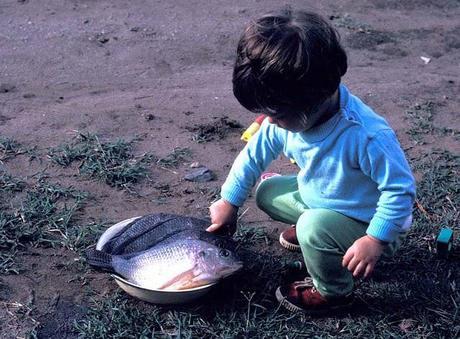
Jennifer pointing to the eye of one of the tilapia (to be our evening's dinner)
July 4, 1971Food supply here is very erratic. For the last three days there haven’t been any eggs and one day we had trouble getting fish. Tilapia–a tender, sweet fish–is the mainstay of our diet. It costs about 10 cents for two large fish. Pineapples, 10 cents each and bananas, 2 cents for four, are the main fruits. Vegetables vary but tomatoes and onions are always available.
Dad, it’s a good thing I used to watch you fillet fish when I was little, because that’s what I have to do every day. I’ve become quite an expert! We throw the remains to the marabou storks who hang around expectantly while we work. The dominant stork in group is apparent by the puffed pouch under its throat.
There are little lizards all over and the other day a four foot snake crawled into my shower as I left. I didn’t wait to see if it was poisonous. Apparently there are some really deadly snakes in the park and I don’t care to run into any of them!
July 5, 1971
Invasion of “dudus”–a small lake fly–in swarms of millions which clung to walls, food, people, and made the air thick.
July 7, 1971
Mary Sue found a baby bat.
Marlers arrived.
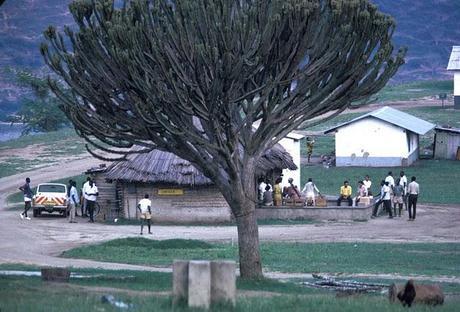
Euphorbia and Canteen, Mweya, Queen Elizabeth National Park
July 8, 1971Showed Judith Marler local shopping spots–duka, market, and canteen–and got chased by a mad elephant twice and accosted by an incoherent drunk in canteen.
Had tea at Lodge.
Art out all night.
July 9, 1971
For excitement lately we have had an earthquake (a small one), an invasion of millions of lake flies (which just as suddenly vanished two days after they arrived), and I was charged by a mad elephant. We were walking to the market and making a wide path around an elephant when suddenly he trumpeted, started flapping his ears, and rushed toward us. Luckily it was only a bluff.
Last night Art and his study partner stayed out all night watching kob with an image intensifier. It is a telescope like thing developed by the army which magnifies any available light so you can see things at night. What Art wanted to find out was whether the animals mate at night like they do in the day and he discovered they did.
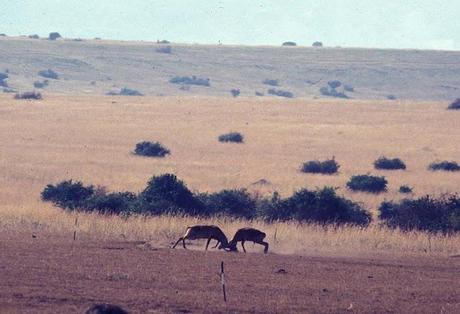
Two male Uganda kob sparring on the lek (mating ground)
July 10, 1971
Trip to Katwe to get our lump of beef at 4/50 shillings per kilo.
July 16, 1971
Awakened in night by violent thunderstorm. Next morning discovered Waser’s tent had blown down and everything got drenched so they spent the night in the VW. Marler’s tent also blew down but they were gone.
July 17, 1971
The other day we had a hard rain, which apparently signals the male termites to come out of the ground. So, in the middle of the night we were awakened by a din, caused by the Africans going out to collect the termites around the lights. In the morning, we saw bowls of them and discarded wings all over the ground. They fry the termites and it is a great delicacy!
July 19, 1971
In evening, Art and Beverly’s seminar on ants.
July 21, 1971
Vast colonies of army ants have made trails across the ground. They are the same ones Art and Beverly studied in the Kibale forest. They go out in a column five to twenty ants wide and throw up dirt on either side forming a trench. On either side “guard”ants stand with their pincers raised, seemingly against potential predators. [One day, Jennifer dropped her teddy bear onto an ant column, and the ants hung on so tight, that I had to cut out patches of the bear’s “fur” to remove them.]
July 24, 1971
In morning, took car trip with Marlers and Mary Sue around Royal Circuit hoping to see lions, but saw only lots of waterbuck and kob, a group of elephants with two babies and hippos at hippo pool.
July 25, 1971
Spent most of afternoon at swimming pool and treated ourselves to ice cream.
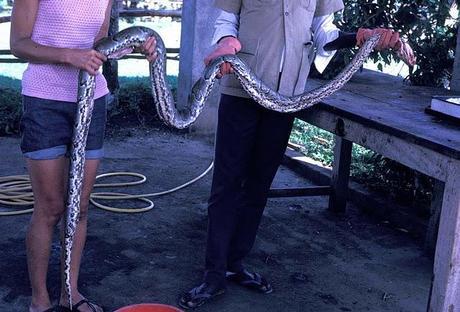
Mary Sue's Python
July 30, 1971Last week Mary Sue and I found a nine foot long baby python. It had been speared through the head and left dead on the side of the road. I didn’t really want to touch it, but Mary Sue wanted to bring it back and skin it, so she did. The skin is really beautiful and will be a great souvenir to hang on her wall. We created quite a sensation by bringing it in and there was a whole crowd of people watching the skinning procedure. Afterwards it was rubbed down with salt, scraped, and dried.

Caroline and Jennifer with baby hippo that was being hand raised by park staff
We are at the end of our stay here. This week Jennifer and I and Mary Sue went on two major sightseeing expeditions. Our first was hiring a Land Rover to take us to the craters, which turned out to be absolutely beautiful in the late afternoon sun. On the way we had two special treats. First, a group of elephants, which included a tiny baby nursing from its mother. The second was a pride of lions on a buffalo they had recently killed. This was the first time I’d seen lions doing anything but sleep (like house cats, they are basically rather lazy.) On Wednesday morning we took a boat trip up the channel. We saw all sorts of birds, lots of hippos, giant monitor lizards, plus elephant, buffalo, and bushbuck. It was a beautiful day and what made the trip most enjoyable was that Jennifer behaved well for the entire three hour ride.July 30, 1971
Punch party at 6:00 in hostel with field course and NUTAE people.
(When the course was over, Art, Jennifer and I spent a week traveling in our rented VW through southwestern Uganda, up to but not across the borders to Burundi and Rwanda, and then back to Kampala. In all, we spent nearly four months in East Africa.)
Update: My friend Pat has traveled to Africa numerous times in recent years, sometimes staying at a private game reserve in South Africa called Leopard Hills. Look at their blog for some amazing video of wildlife (lions, leopards, and more!) seen close up.
